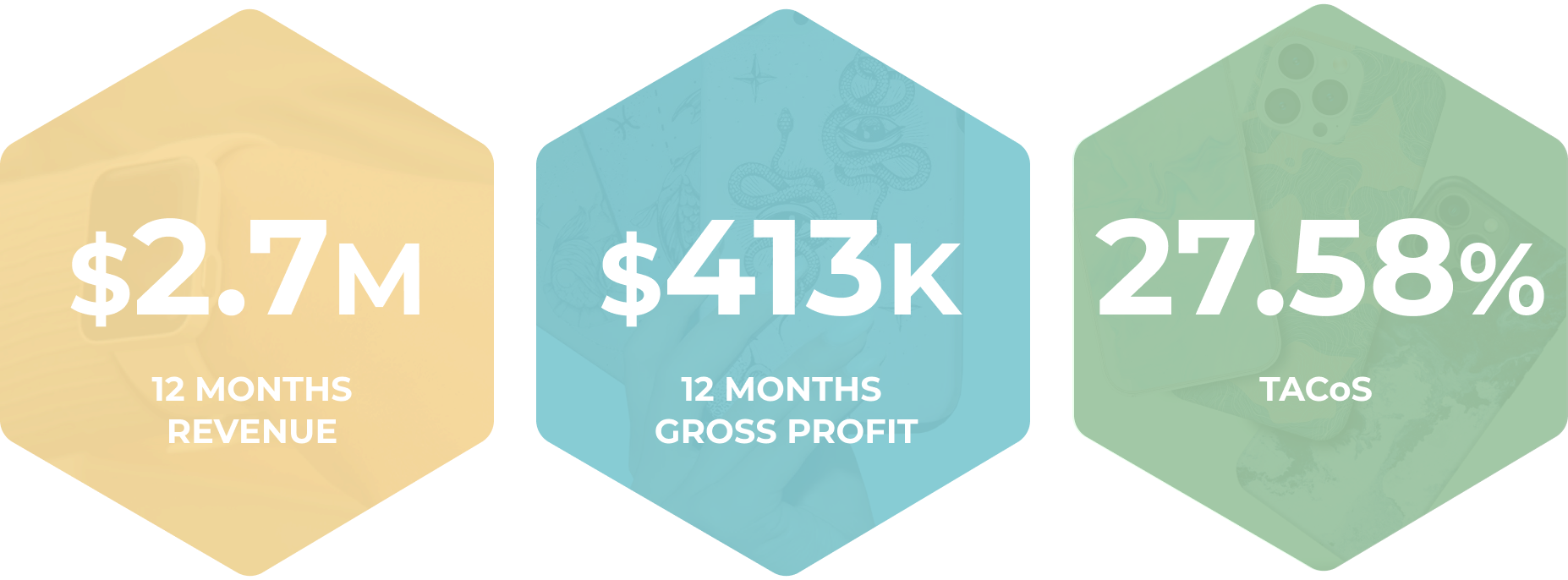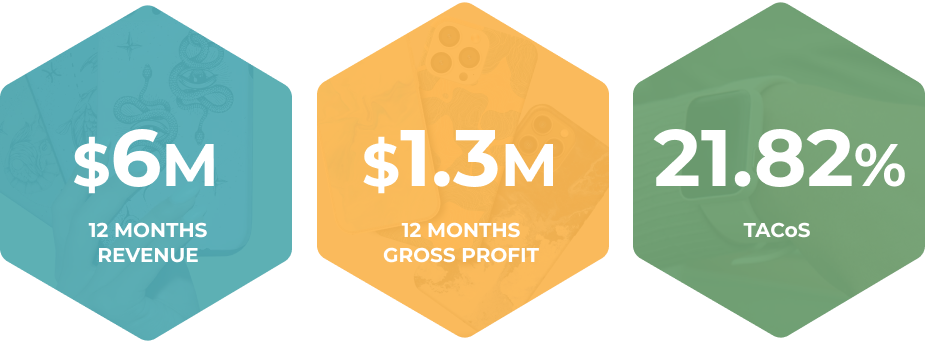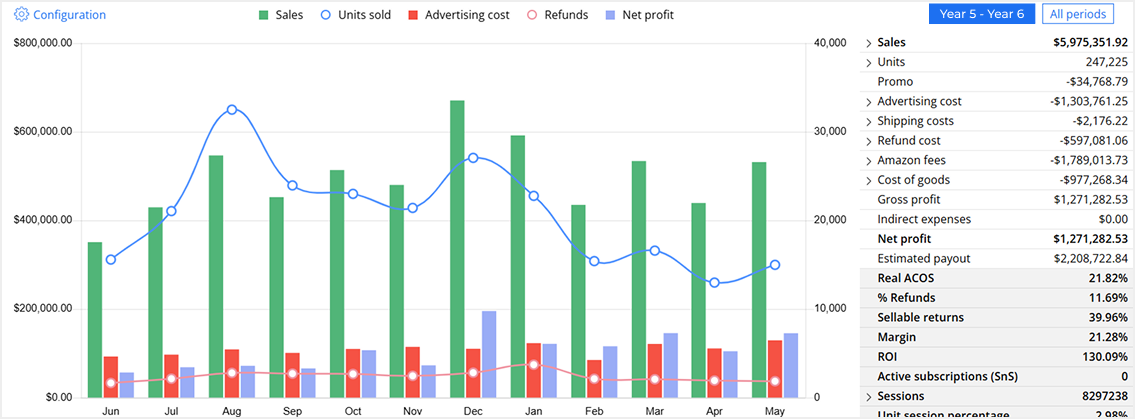Growing an Amazon brand is never easy. Especially in a highly saturated niche where one of our clients has chosen to grow. We started our journey with this small European fashion brand from the ground up around 6 years ago.
Together, we worked relentlessly to build a strong foundation and drive growth. In the first 3-4 years, we crafted a successful strategy that helped our brand position itself as a premium brand with niche designs and reached an average yearly revenue of ~ $ 3,000,000
However, after several years, we reached a growth plateau where traditional tactics were no longer enough. To continue scaling, we needed to rethink our approach and refine our strategy to stand out in the Amazon Jungle.
Growing an Amazon brand is never easy. Especially in a highly saturated niche where one of our clients has chosen to grow. We started our journey with this small European fashion brand from the ground up around 6 years ago.
Together, we worked relentlessly to build a strong foundation and drive growth. In the first 3-4 years, we crafted a successful strategy that helped our brand position itself as a premium brand with niche designs and reached an average yearly revenue of ~ $ 3,000,000
However, after several years, we reached a growth plateau where traditional tactics were no longer enough. To continue scaling, we needed to rethink our approach and refine our strategy to stand out in the Amazon Jungle.
Growing an Amazon brand is never easy. Especially in a highly saturated niche where one of our clients has chosen to grow. We started our journey with this small European fashion brand from the ground up around 6 years ago.
Together, we worked relentlessly to build a strong foundation and drive growth. In the first 3-4 years, we crafted a successful strategy that helped our brand position itself as a premium brand with niche designs and reached an average yearly revenue of ~ $ 3,000,000
However, after several years, we reached a growth plateau where traditional tactics were no longer enough. To continue scaling, we needed to rethink our approach and refine our strategy to stand out in the Amazon Jungle.
Growing an Amazon brand is never easy. Especially in a highly saturated niche where one of our clients has chosen to grow. We started our journey with this small European fashion brand from the ground up around 6 years ago.
Together, we worked relentlessly to build a strong foundation and drive growth. In the first 3-4 years, we crafted a successful strategy that helped our brand position itself as a premium brand with niche designs and reached an average yearly revenue of ~ $ 3,000,000
However, after several years, we reached a growth plateau where traditional tactics were no longer enough. To continue scaling, we needed to rethink our approach and refine our strategy to stand out in the Amazon Jungle.
Despite the solid foundation, our sales had reached a plateau. This is a common hurdle on Amazon, but that didn't make it any less frustrating. One major issue was fulfillment. A significant number of orders were being shipped via Fulfillment by Merchant (FBM). It took too long to reach customers, impacting satisfaction and repeat purchases.
Another challenge has occurred: shifting our advertising from just one top-selling product. Now, we needed a balanced approach for new launches that weren’t gaining traction.
Keyword targeting was also a challenge to consider. The cheap, generic keyword targeting didn’t work for our high-end products. Most of these generic search terms attracted bargain shoppers when we were looking for custom design lovers.
The result? High competition, rising costs-per-click (CPC), and lower conversions. We needed a better way forward.
Something had to change.
Despite the solid foundation, our sales had reached a plateau. This is a common hurdle on Amazon, but that didn't make it any less frustrating. One major issue was fulfillment. A significant number of orders were being shipped via Fulfillment by Merchant (FBM). It took too long to reach customers, impacting satisfaction and repeat purchases.
Another challenge has occurred: shifting our advertising from just one top-selling product. Now, we needed a balanced approach for new launches that weren’t gaining traction.
Keyword targeting was also a challenge to consider. The cheap, generic keyword targeting didn’t work for our high-end products. Most of these generic search terms attracted bargain shoppers when we were looking for custom design lovers.
The result? High competition, rising costs-per-click (CPC), and lower conversions. We needed a better way forward.
Something had to change.
Instead of tweaking the same old methods that worked wonders in the past and helped this brand reach stable $2.8M- $3.3M annual sales, we took a bold step in a new direction. We optimized fulfillment, expanded the product range, overhauled the advertising structure, and refined our pricing strategy.
Let’s dive deeper into each turning point along the road:
1. From Keyword Targeting to ASIN Targeting Strategy
We shifted a significant part of our ad budget from keyword targeting to ASIN targeting. What was our strategy?
We placed our products under carefully selected competitors' listings instead of battling over high-competition keywords.
2. Transition to FBA for Faster Delivery
Delivery speed was a pain point. Around 30% of our orders were shipped via FBM from Europe, and it took 2-3 weeks, leading to unhappy customers. We managed to shift this number to ~ 10% in 6 months. Eventually, we fully switched to the fulfilled-by-Amazon (FBA) method, which gave us a better edge. Faster deliveries mean higher customer satisfaction, improved CVR, and a smoother shopping experience.
3. Revamping Our Advertising Strategy
We reimagined our entire ad approach. Instead of putting all our budget behind a single "hero product," we spread it across multiple products in the same variation. This lets us test every design directly on the market and see how each one performs.
We paused the designs that didn’t convert and focused our spend on the ones that did. As a result, we cut wasted budget, improved traffic quality, and boosted our CTR and CVR. The strategy led to stronger ACoS and ROAS.
Our team made a key shift to ASIN-based Sponsored Products, Brands, and Display campaigns. We analyzed reports and the niche and found competitors dominating the market, particularly, highly relevant and high-traffic search terms. Attacking their real estate beneath their listings with several of our parent variations gave us much better visibility at a lower CPC. This approach made every advertising dollar work harder.
Bear in mind that the niche is massive and competitive. Even if you 10x increase the ad spend, this is barely enough to start scratching the bottom of the barrel in terms of potential traffic. However, we still managed to generate more traffic because of the products’ premium quality.
We strengthened our Defense Strategy campaigns, targeting our listings to protect our market share. This move kept customers engaged with our brand and minimized traffic losses to competitors.
4. Expanding the Product Catalog
We launched 13 new FBA product designs, bringing our catalog to 16 core designs and over 80 new SKUs. More variety meant more choices for buyers and improved sales performance across all categories.
Understanding consumer behavior was crucial. People who want to buy more generic products than ours tend to compare multiple listings before purchasing. ASIN targeting helped us appear on competing products’ listings, ensuring we stayed in the buyer's consideration set.
5. Rethinking Our Keyword Strategy
We built more extensive Sponsored Products campaigns instead of using one keyword target per campaign. Each campaign contains 5-20 keyword targets from the same “keyword family." This allowed Amazon A9 to work its magic and us to optimize our strategy for the best-performing keywords dynamically. However, we still retained the best-performing individual targets in their own campaigns for maximum optimization capacity.
The result? Better efficiency, stronger campaign performance, and smarter ad spend.
The cost? We won’t be able to micromanage every target with placements, individual budgets, and bidding strategy.
6. A Strategic Price Adjustment
Pricing is always a balancing act. For 2 months, we have carefully increased the price by 50%, positioning the brand as a premium, high-quality choice. Despite the higher price point, sales remained stable and outperformed previous years. We still plan to test increasing the price further at a later date.
Instead of tweaking the same old methods that worked wonders in the past and helped this brand reach stable $2.8M- $3.3M annual sales, we took a bold step in a new direction. We optimized fulfillment, expanded the product range, overhauled the advertising structure, and refined our pricing strategy.
Let’s dive deeper into each turning point along the road:
1. From Keyword Targeting to ASIN Targeting Strategy
We shifted a significant part of our ad budget from keyword targeting to ASIN targeting. What was our strategy?
We placed our products under carefully selected competitors' listings instead of battling over high-competition keywords.
2. Transition to FBA for Faster Delivery
Delivery speed was a pain point. Around 30% of our orders were shipped via FBM from Europe, and it took 2-3 weeks, leading to unhappy customers. We managed to shift this number to ~ 10% in 6 months. Eventually, we fully switched to the fulfilled-by-Amazon (FBA) method, which gave us a better edge. Faster deliveries mean higher customer satisfaction, improved CVR, and a smoother shopping experience.
3. Revamping Our Advertising Strategy
We reimagined our entire ad approach. Instead of putting all our budget behind a single "hero product," we spread it across multiple products in the same variation. This lets us test every design directly on the market and see how each one performs.
We paused the designs that didn’t convert and focused our spend on the ones that did. As a result, we cut wasted budget, improved traffic quality, and boosted our CTR and CVR. The strategy led to stronger ACoS and ROAS.
Our team made a key shift to ASIN-based Sponsored Products, Brands, and Display campaigns. We analyzed reports and the niche and found competitors dominating the market, particularly, highly relevant and high-traffic search terms. Attacking their real estate beneath their listings with several of our parent variations gave us much better visibility at a lower CPC. This approach made every advertising dollar work harder.
Bear in mind that the niche is massive and competitive. Even if you 10x increase the ad spend, this is barely enough to start scratching the bottom of the barrel in terms of potential traffic. However, we still managed to generate more traffic because of the products’ premium quality.
We strengthened our Defense Strategy campaigns, targeting our listings to protect our market share. This move kept customers engaged with our brand and minimized traffic losses to competitors.
4. Expanding the Product Catalog
We launched 13 new FBA product designs, bringing our catalog to 16 core designs and over 80 new SKUs. More variety meant more choices for buyers and improved sales performance across all categories.
Understanding consumer behavior was crucial. People who want to buy more generic products than ours tend to compare multiple listings before purchasing. ASIN targeting helped us appear on competing products’ listings, ensuring we stayed in the buyer's consideration set.
5. Rethinking Our Keyword Strategy
We built more extensive Sponsored Products campaigns instead of using one keyword target per campaign. Each campaign contains 5-20 keyword targets from the same “keyword family." This allowed Amazon A9 to work its magic and us to optimize our strategy for the best-performing keywords dynamically. However, we still retained the best-performing individual targets in their own campaigns for maximum optimization capacity.
The result? Better efficiency, stronger campaign performance, and smarter ad spend.
The cost? We won’t be able to micromanage every target with placements, individual budgets, and bidding strategy.
6. A Strategic Price Adjustment
Pricing is always a balancing act. For 2 months, we have carefully increased the price by 50%, positioning the brand as a premium, high-quality choice. Despite the higher price point, sales remained stable and outperformed previous years. We still plan to test increasing the price further at a later date.

Now, let's look at the numbers. 12 months before our strategic overhaul on year 4-5:


Now, let's look at the numbers. 12 months before our strategic overhaul on year 4-5:


One year later, during the same period on year 5-6, results improved significantly:



One year later, during the same period on year 5-6, results improved significantly:


The impact was undeniable. Our refined ASIN targeting, expanded catalog, and optimized ad spend drove impressive growth:
This transformation wasn’t just about better numbers. It was about making bold, strategic moves that changed the trajectory of the brand.
We proved that growth doesn’t come from doing more of the same when plateauing. It comes from experimenting and trying new things.
What worked to get you to $3M probably won’t work to reach $10M or $ 30M. Every new revenue milestone needs a different playbook.
By challenging old habits and embracing data-driven decisions, we helped our client break free from stagnation and unlock their next chapter of success.
The impact was undeniable. Our refined ASIN targeting, expanded catalog, and optimized ad spend drove impressive growth:
This transformation wasn’t just about better numbers. It was about making bold, strategic moves that changed the trajectory of the brand.
We proved that growth doesn’t come from doing more of the same when plateauing. It comes from experimenting and trying new things.
What worked to get you to $3M probably won’t work to reach $10M or $ 30M. Every new revenue milestone needs a different playbook.
By challenging old habits and embracing data-driven decisions, we helped our client break free from stagnation and unlock their next chapter of success.